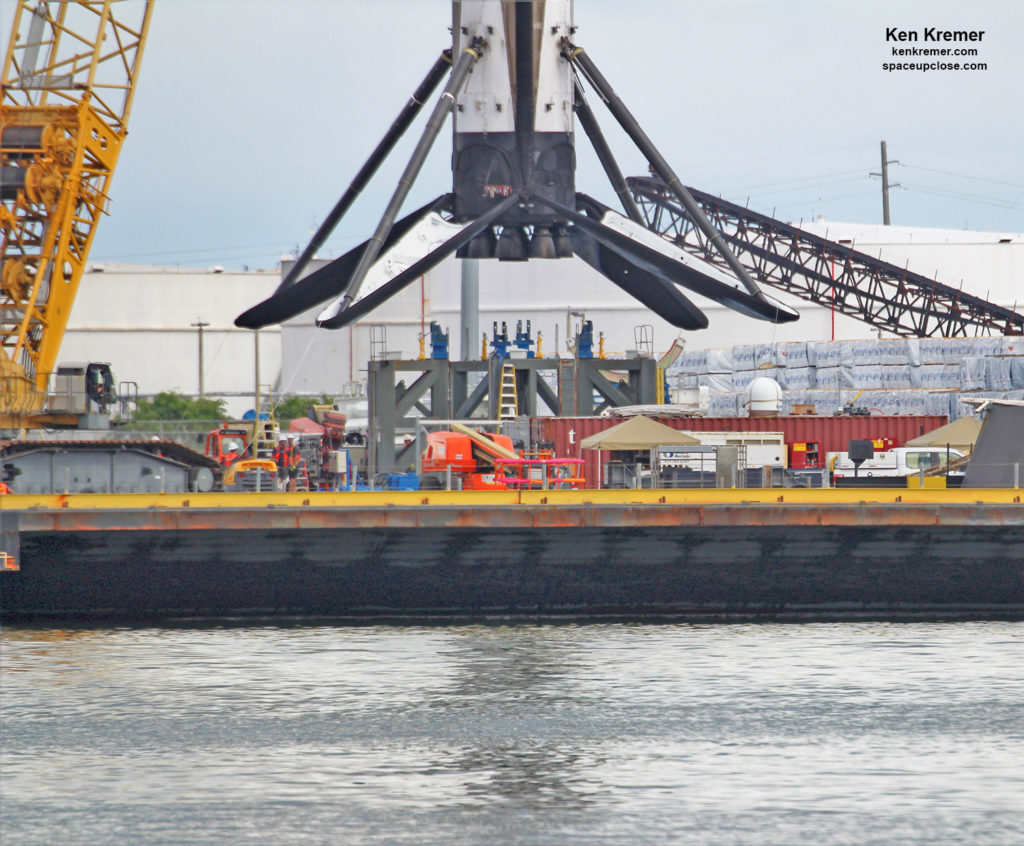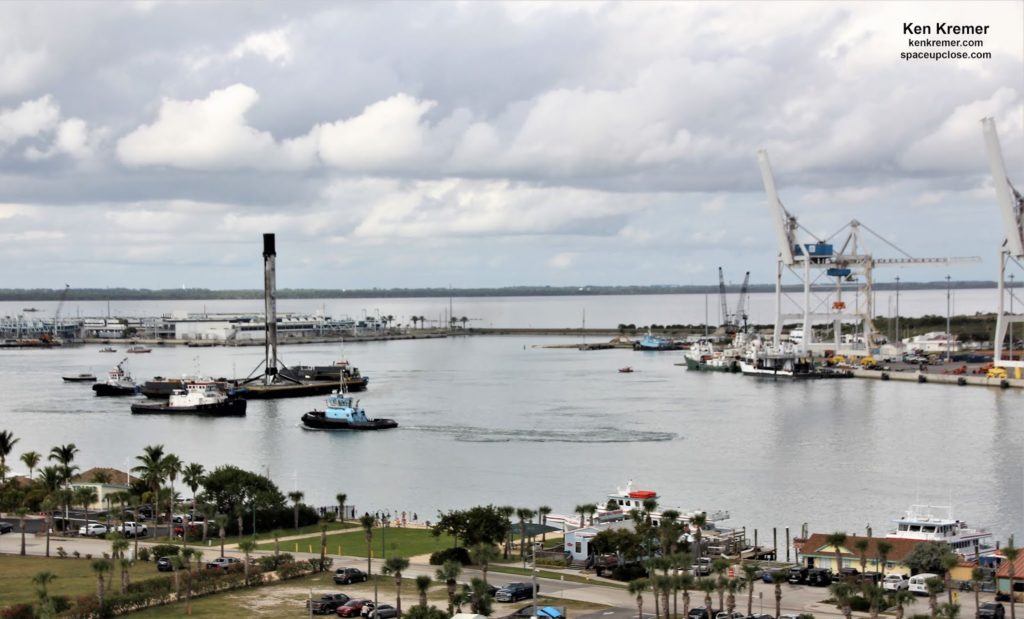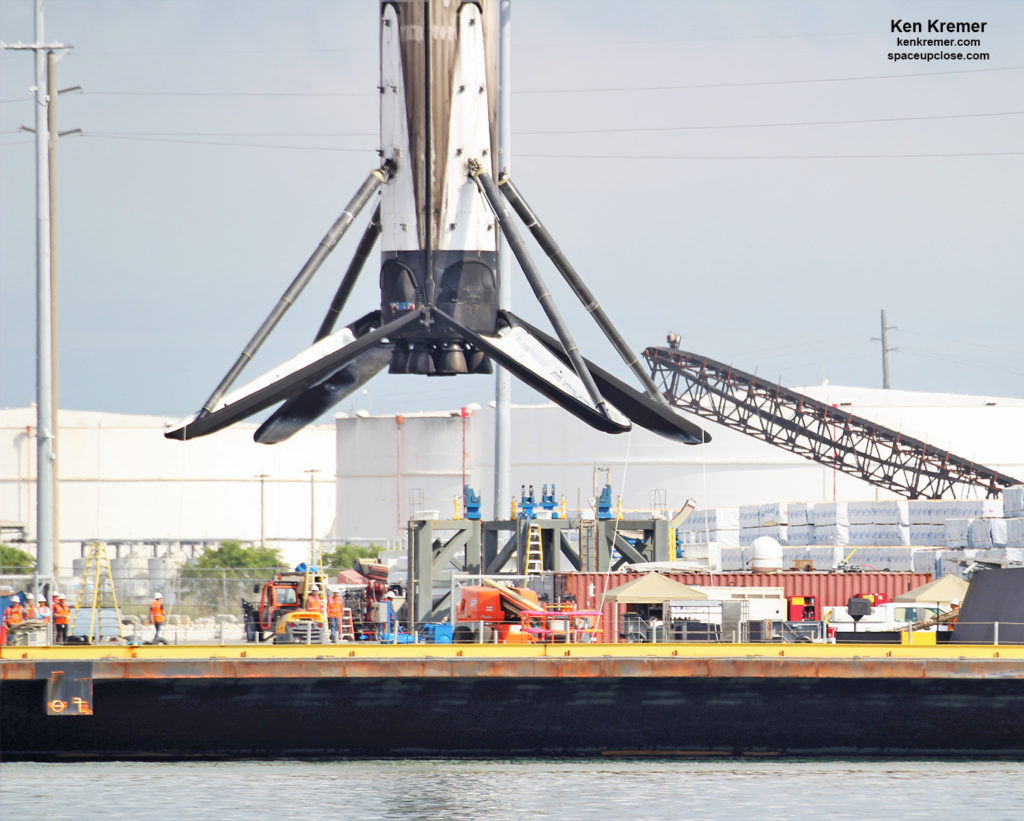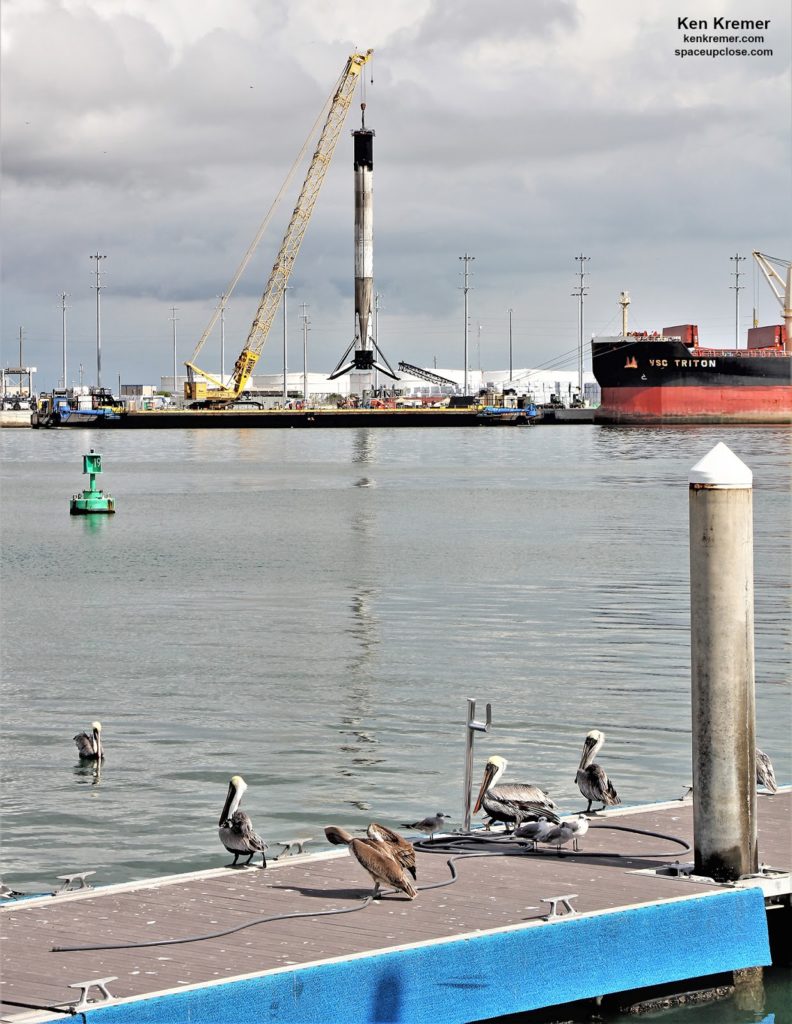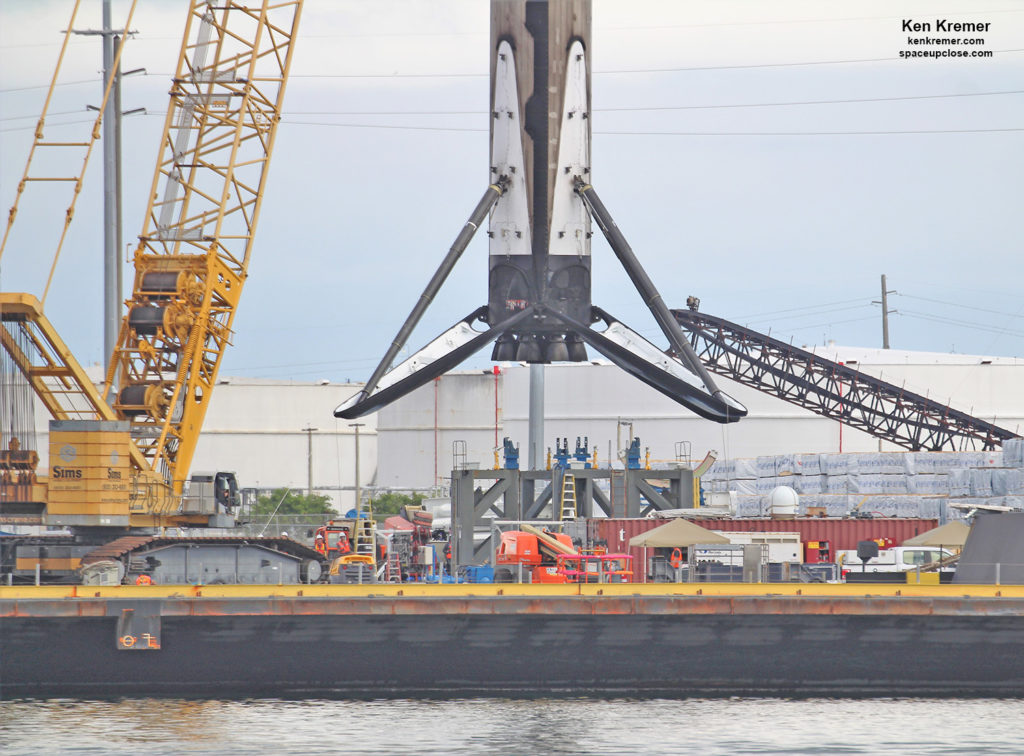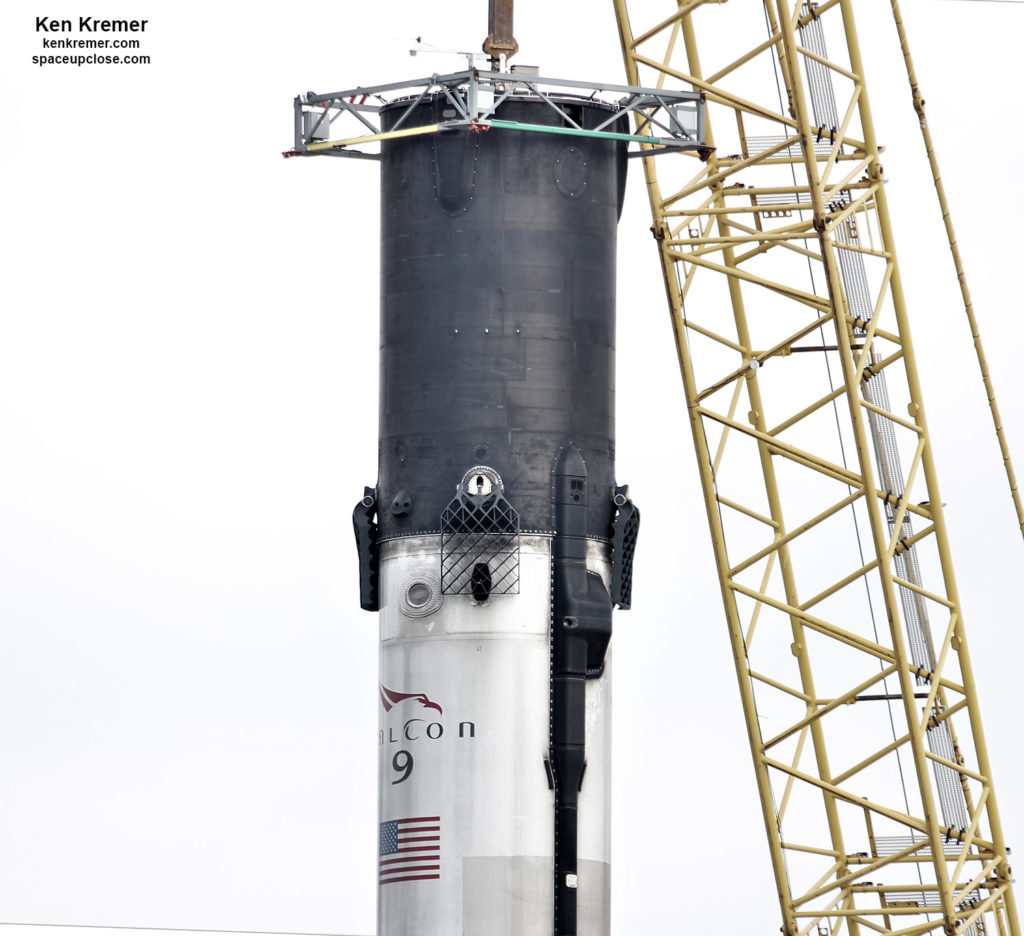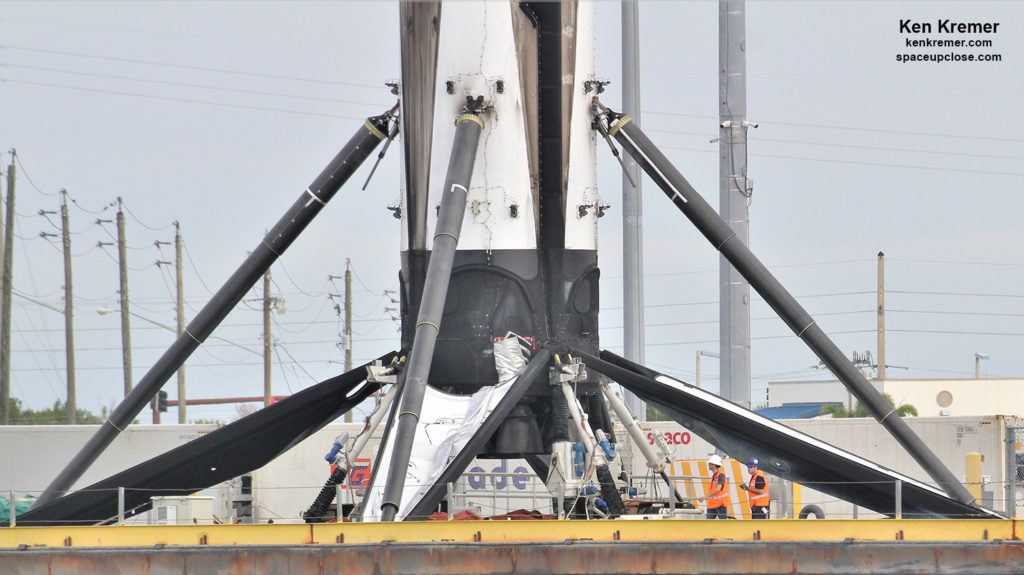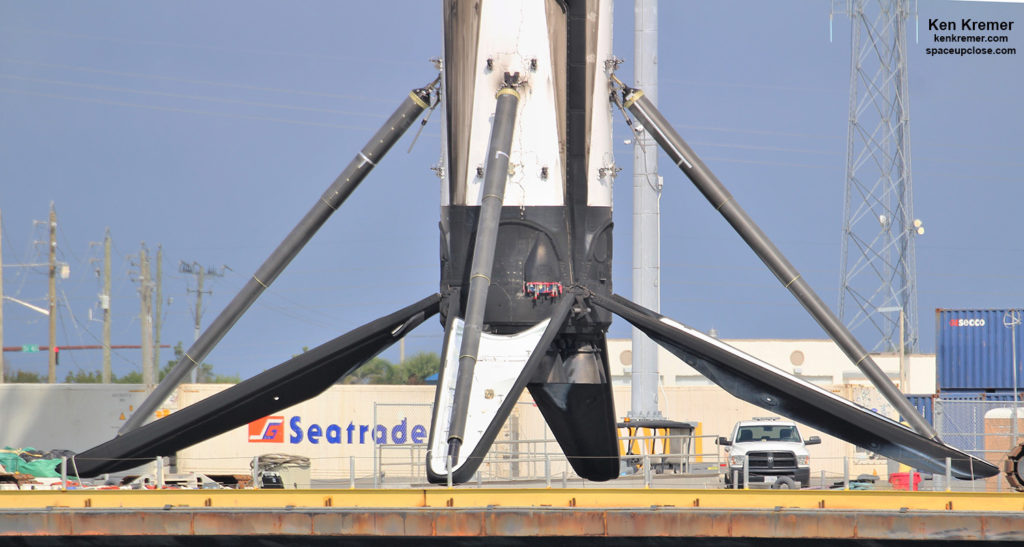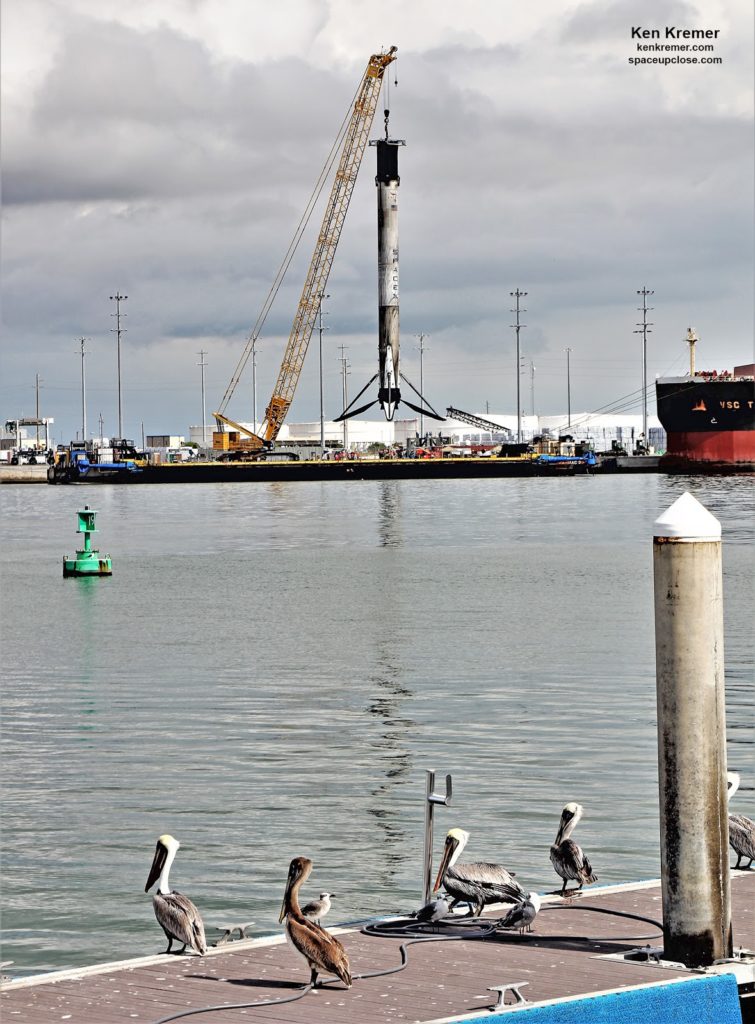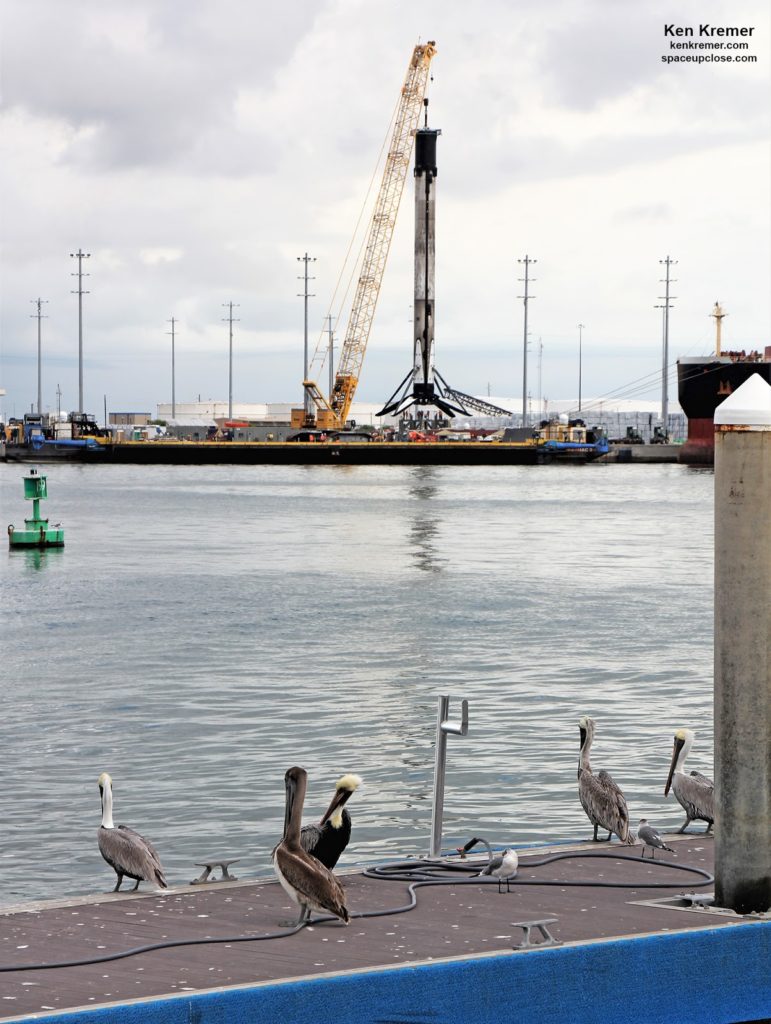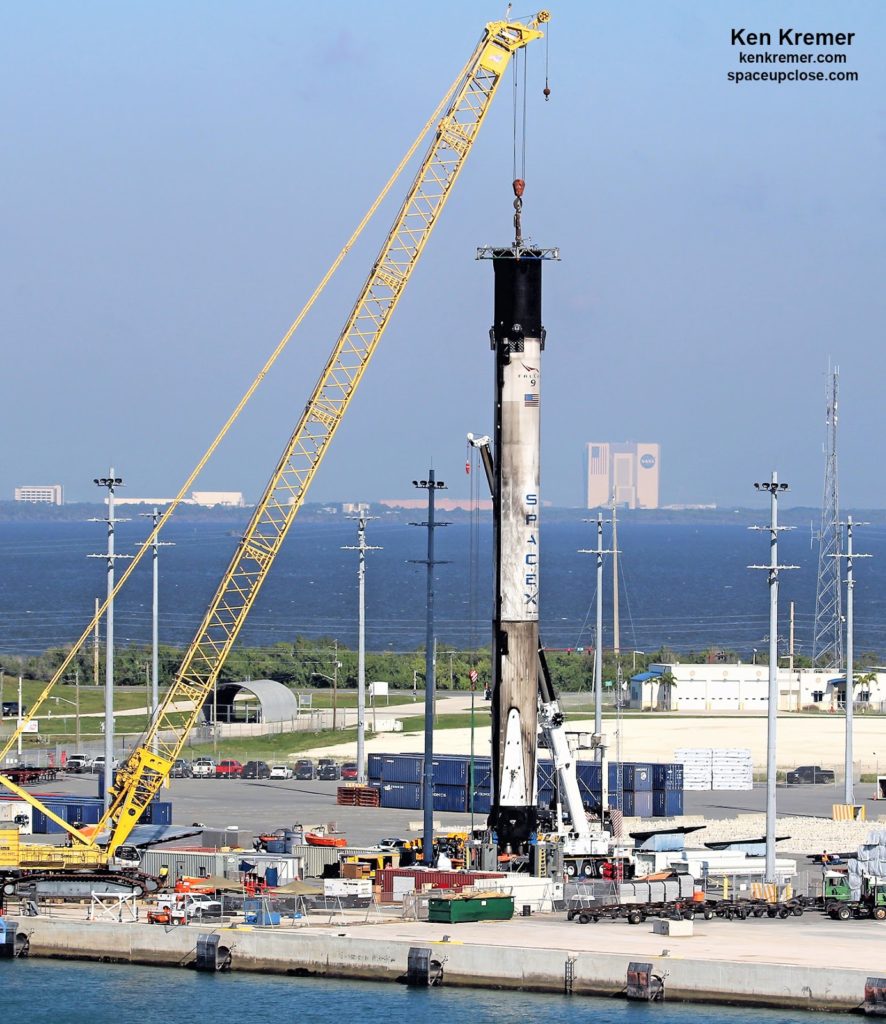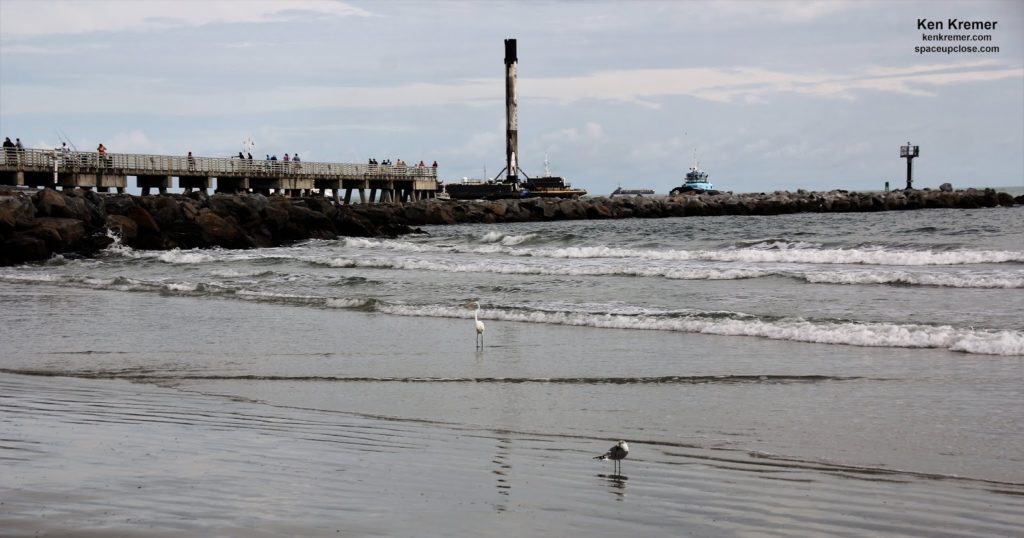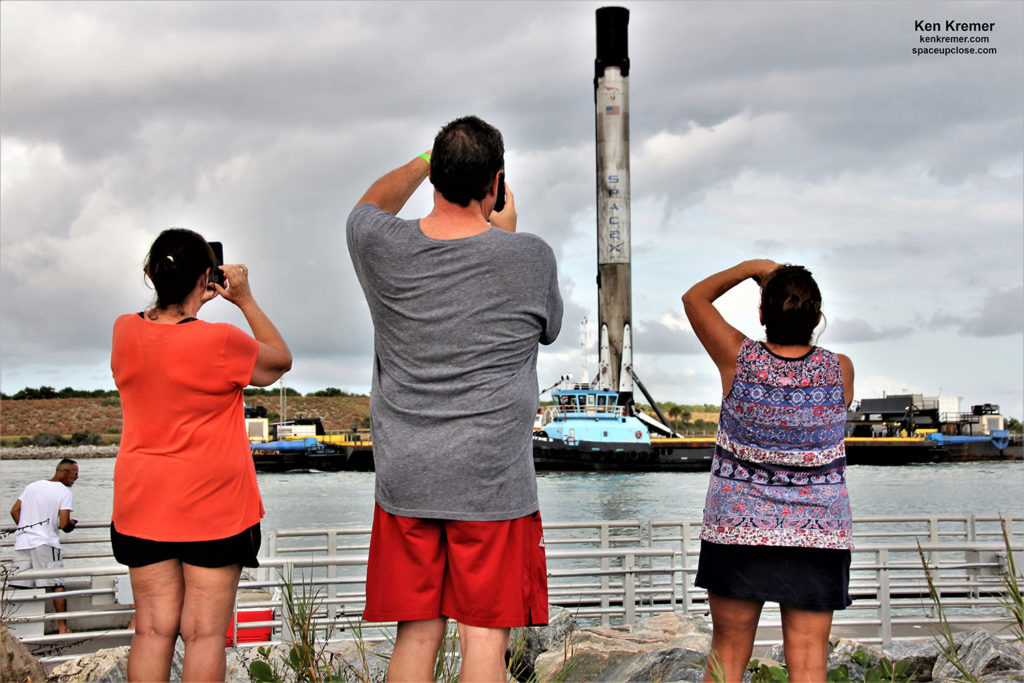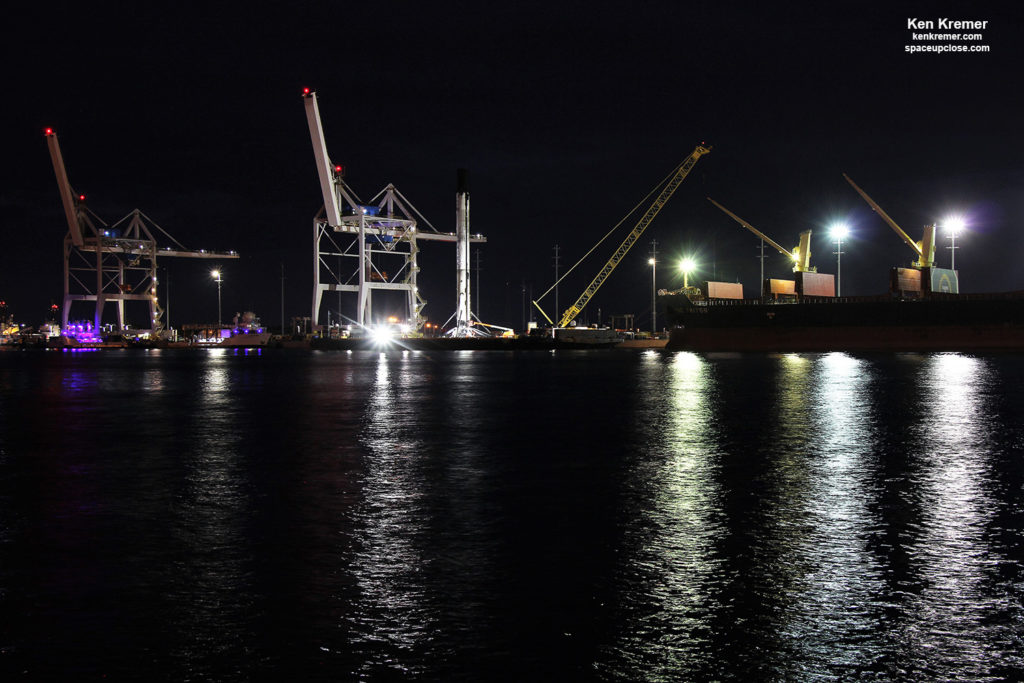Ken Kremer —SpaceUpClose.com &
RocketSTEM –20 November 2018
PORT CANAVERAL,
FL – After the recovered SpaceX Falcon 9
first stage booster from the Es’hail-2 comsat launch and landing sailed back into Port Canaveral atop
the OCISLY droneship on Monday, Nov. 19, and docked at the north side of the
channel later in the day, work crews ended their work for the day, and decided to
resume efforts early Tuesday, Nov. 20, to crane the twice used rocket off the
ship from sea to terra firma.
Given the midday Monday arrival time, the work crews apparently had
insufficient time to proceed further with the spent rocket – standing upright and
clamped firmly in place on the ‘Of Course I Still Love
You’ (OCISLY) drone ship platform.
Ultimately the four landing legs were all detached with no effort
directed to retraction.
So bright and early Tuesday morning, Nov. 20, they proceeded to pick
up where they left off and started by attaching the high tech hoisting cap
device.
We informally call the square-shaped cage-like hoisting device the ‘Booster Lift/Leg Retraction Device’ or BLLRD.
Check out my Space UpClose gallery
of eyewitness photos detailing the craning of the booster from OCISLY to the
work cradle mounting platform on land – located a short distance away and estimated
at perhaps 200 feet (60 m) or so.
Click back for more photos as the
gallery grows.
The now twice ‘flight-proven’ and
twice ‘ocean-landed’ 1st stage booster was towed into Port Canaveral
channel around 12:30 p.m. EST (1730 GMT) Nov.
19, 2018.
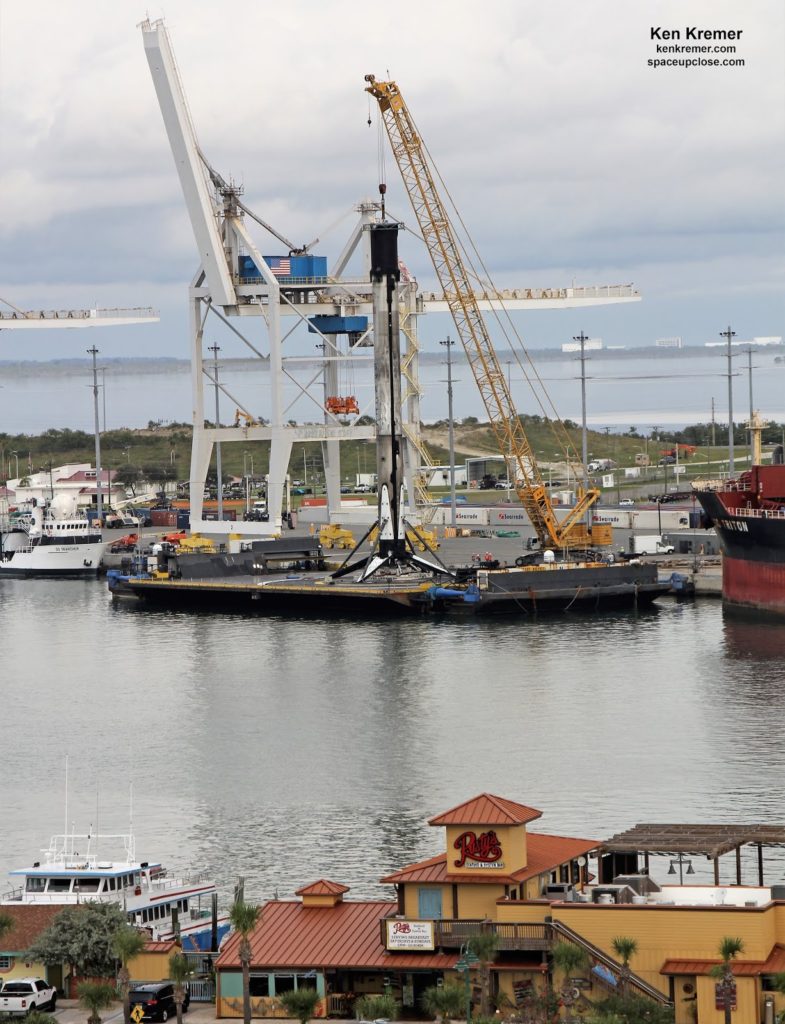 |
| Credit: Ken Kremer/kenkremer.com/spaceupclose.com |
The 156 foot tall Falcon 9 first
stage was standing virtually perfectly upright on the OCISLY drone ship platform upon which it successfully soft landed propulsively
at sea – with all four landing legs fully
deployed.
miles (640 km) off shore in the Atlantic Ocean a few days prior to the
scheduled liftoff.
was to install the BLLRD on top of the 15-story-tall booster standing atop the ship.
The square-shaped cage-like BLLRD apparatus
was noticeably different Tuesday from its prior incarnation and use on the
recovered Telstar 18v booster in September.
The BLLRD was rather stripped down –
a good indication that the SpaceX engineers decided to simply dissect off all 4
legs from the start rather than try and retract them experimentally like for
Telstar 18v – as CEO Elon Musk said was
the ultimate goal to enable quick launch turnaround in as little as 24 hours for the Block 5 version of Falcon 9.
absent were the pullies, cables and stabilizers installed on the square shaped cage
– which still held the circular hoisting cap, and can be operated remotely. The
BLLRD was raised into place by the crane operator around 8 a.m. ET Tuesday and
mounted firmly.
It is also apparently powered by a
trio of solar panels – seen in side views.
Thus far the cables have been used in
experimental efforts to retract the landing legs.
In the end, the technicians made no
attempt at all to retract the legs. That will have to wait for a future recovered
Falcon 9 sometime in 2019.
Next they unclamped the octograbber
and detached all the restraining chains holding the rocket legs firmly onto the
deck of OCISLY.
The crane operator and technicians
then began hoisting the Falcon 9 first stage booster off OCISLY in a
choreographed operation that began around 11:35 a.m. ET Nov. 20. Overall it and took about 20 min until being completed
around 11:55 a.m. ET.
operator swung the crane around to the back and moved the booster a short
distance to a cradle mounting platform onshore a short distance away that holds
the booster firmly in place for leg detachment or retraction.
As has been their habit all along,
the work team mounted the platform mounting cradle to monitor the booster
placement as it was lowered into place the last 6 feet or so.
The technicians then prepared the
booster core and four landing legs for disassembly and detachment by a process
that looks quite like an insect dissection.
The team methodically removes the landing
struts and then separately the landing pads in an operation accomplished at
days end after nightfall – in this instance.
Historically it takes the workers roughly 2 to 3
hours crews for unbolting, detaching and dissecting off all 4 landing struts
and all 4 landing pads.
Landing leg retraction was touted by
SpaceX CEO and billionaire founder Elon Musk as a key improvement milestone
toward the goal of achieving far faster turnaround of ‘Flight-Proven’ first
stages for the significantly improved Block 5 version Falcon 9 vs. the older
and now retired Block 4 first stages.
In fact Musk said he aims for his
SpaceX team to launch, land and relaunch the same booster within a 24 hour
period.
SpaceX launched the Falcon 9
carrying the six ton Es’hail-2
telecommunications satellite at 3:46 p.m.
EST (2046 GMT) Thursday, Nov. 15, from pad 39A at NASA’s Kennedy Space Center.
This marked the first daytime launch since May from Florida’s spaceport.
This reused booster was previously used to launch the Telstar 19V
telecomsat on July 22, 2018 for Canadian-based Telesat.
The 229-foot-tall (70 meters) Falcon 9 successfully delivered the Es’hail
2 satellite for Qatar to its intended geostationary transfer orbit. Subsequently
the satellite will be raised to geostationary orbit circling Earth 22,500 miles
(36,000 kilometers) over the equator.
The precision guided rocket assisted
soft landing of the 156 foot tall booster on OCISLY took place just over eight minutes
after launch from KSC. All 4 landing legs successfully deployed in the last
seconds.
This landing counts as the 31st
successful landing overall and the 18th by sea.
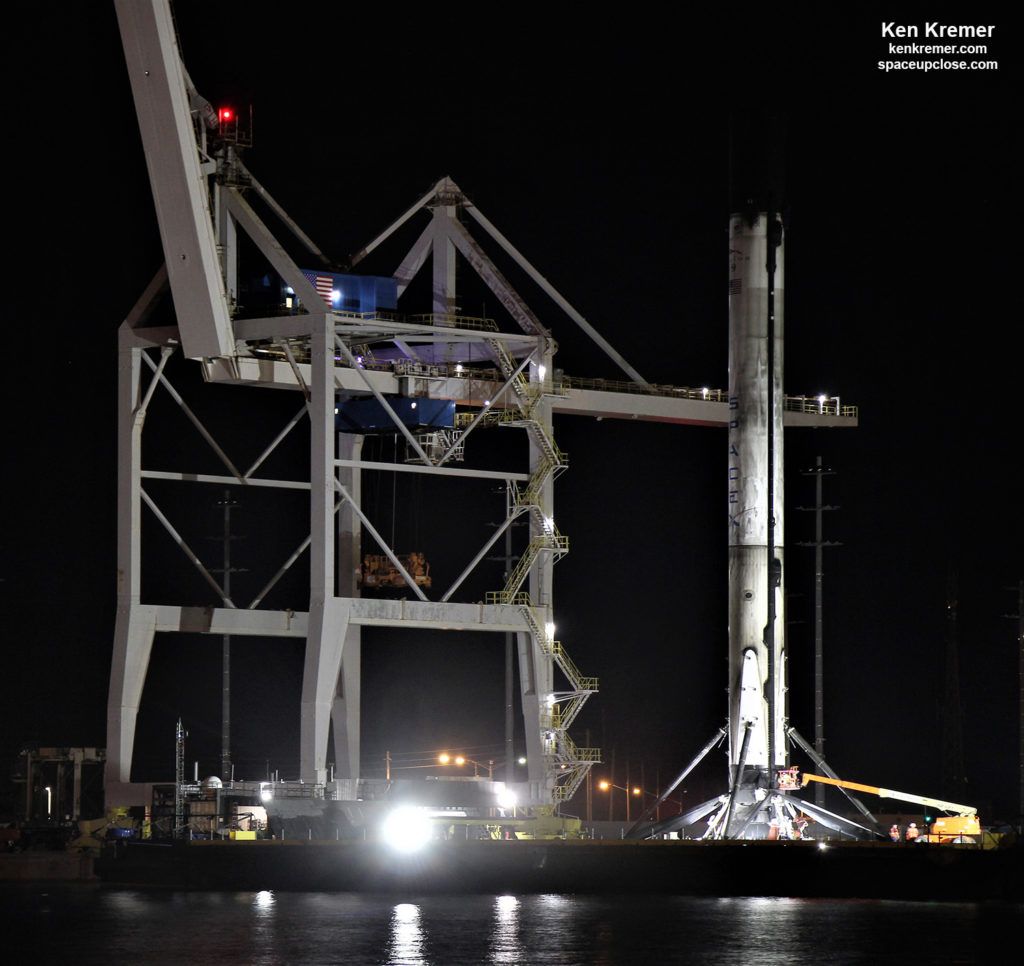 |
| Credit: Ken Kremer/kenkremer.com/spaceupclose.com |
 |
| Credit: Ken Kremer/kenkremer.com/spaceupclose.com |
SpaceX’s
next launch from Florida is slated for no earlier than Dec. 4 on the Dragon
CRS-16 cargo resupply mission for NASA to the International Space Station (ISS).
Watch for Ken’s continuing onsite coverage of NASA, SpaceX, ULA,
Boeing, Lockheed Martin, Northrop Grumman and more space and mission reports
direct from the Kennedy Space Center, Cape Canaveral Air Force Station, Florida
and Wallops Flight Facility, Virginia.
Stay tuned here for Ken’s continuing Earth and Planetary science
and human spaceflight news: www.kenkremer.com –www.spaceupclose.com – twitter
@ken_kremer – email: ken at kenkremer.com
Dr. Kremer is a research
scientist, journalist and photographer based in the KSC area.
………….
Ken’s photos are for sale and he is available for lectures and outreach events


